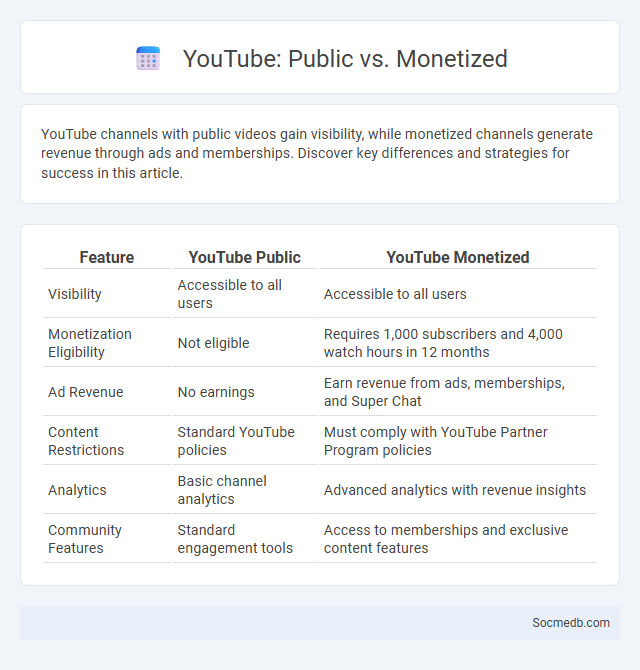
Photo illustration: YouTube Public vs Monetized
YouTube channels with public videos gain visibility, while monetized channels generate revenue through ads and memberships. Discover key differences and strategies for success in this article.
Table of Comparison
| Feature | YouTube Public | YouTube Monetized |
|---|---|---|
| Visibility | Accessible to all users | Accessible to all users |
| Monetization Eligibility | Not eligible | Requires 1,000 subscribers and 4,000 watch hours in 12 months |
| Ad Revenue | No earnings | Earn revenue from ads, memberships, and Super Chat |
| Content Restrictions | Standard YouTube policies | Must comply with YouTube Partner Program policies |
| Analytics | Basic channel analytics | Advanced analytics with revenue insights |
| Community Features | Standard engagement tools | Access to memberships and exclusive content features |
Understanding YouTube Video Privacy Settings
YouTube video privacy settings include Public, Unlisted, Private, and Scheduled options, allowing creators to control who can view their content. Public videos are accessible to everyone, Unlisted videos are viewable only by those with the link, and Private videos are limited to specific users chosen by the uploader. Properly managing these settings enhances content security and audience targeting on the platform.
What is a Public YouTube Video?
A public YouTube video is accessible to anyone on the platform without restrictions, making it visible in search results, recommendations, and channel pages. Your content can reach a broad audience instantly, increasing visibility and engagement. These videos contribute to building brand awareness and growing your online presence through open accessibility.
What Does Monetized Video Mean on YouTube?
Monetized video on YouTube refers to content that generates revenue for the creator through ads, channel memberships, or Super Chat during live streams. YouTube creators must join the YouTube Partner Program (YPP) and meet specific eligibility criteria, including 1,000 subscribers and 4,000 watch hours in the past 12 months, to enable monetization features. Monetized videos leverage targeted advertising algorithms to maximize earnings based on viewer demographics, video engagement, and niche relevance.
Key Differences Between Public and Monetized Videos
Public videos on social media are accessible to all users, maximizing reach and engagement without direct revenue generation. Monetized videos are specifically designed to generate income through ads, sponsorships, or subscriptions, often requiring adherence to platform policies and quality standards. Your choice between public and monetized videos impacts audience targeting, content strategy, and revenue potential on social media platforms.
Visibility and Audience Reach Comparison
Social media platforms significantly differ in visibility and audience reach, with Facebook boasting over 2.9 billion active users, making it ideal for broad exposure. Instagram excels in visual content engagement, attracting younger audiences with a focus on images and short videos. You can maximize your brand's impact by choosing platforms aligned with your target demographics and content style.
Monetization Eligibility Requirements
Social media platforms typically require users to meet specific Monetization Eligibility Requirements such as maintaining a minimum follower count, adhering to community guidelines, and consistently generating original content to qualify for revenue-sharing programs. Platforms like YouTube mandate at least 1,000 subscribers and 4,000 watch hours in the past 12 months, while Instagram and Facebook require creator accounts with frequent engagement and authentic interactions. These criteria ensure that monetizing accounts contribute valuable content and maintain platform integrity.
Revenue Potential for Public vs Monetized Videos
Public videos on social media platforms generate revenue primarily through ad impressions and increased viewer engagement, contributing to brand exposure and long-term monetization. Monetized videos, equipped with direct revenue streams like ad placements, sponsorships, and subscription models, typically yield higher and more immediate earnings. Platforms such as YouTube and Facebook optimize algorithms to prioritize monetized content, maximizing revenue potential by targeting ads to engaged audiences.
Impact on Channel Growth and Analytics
Social media platforms significantly influence channel growth by driving targeted traffic and increasing audience engagement through tailored content strategies and algorithm optimization. Advanced analytics tools provide You with detailed insights into viewer demographics, behavior patterns, and content performance, enabling data-driven decisions to optimize reach and retention. Leveraging these analytics enhances your ability to adapt content, maximize growth opportunities, and improve influencer marketing effectiveness.
Best Practices for Publishing Videos
Optimizing video content for social media requires concise storytelling, engaging visuals, and clear branding to capture audience attention. Using native video upload features on platforms like Facebook, Instagram, and LinkedIn enhances playback quality and algorithmic reach. Incorporating captions, custom thumbnails, and optimal video lengths--typically under two minutes--boost viewer engagement and retention rates.
Choosing the Right Setting for Your YouTube Content
Choosing the right setting for your YouTube content enhances viewer engagement and boosts watch time by creating a visually appealing and relevant backdrop. Natural lighting, minimal background noise, and organized spaces tailored to your video's theme ensure professional quality that keeps your audience focused. Your choice influences video SEO performance by increasing viewer retention and encouraging likes, shares, and comments.
 socmedb.com
socmedb.com